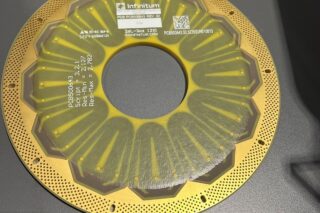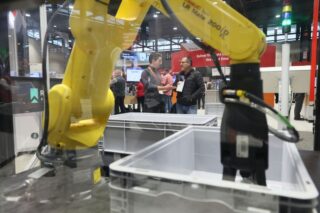The Euro Airship promises to transform the landscape of air transport. With its solar sails and low carbon footprint, this airship offers opportunities for various applications, from surveillance to logistics to tourism. At the Global Industrie exhibition in Paris, we met with Marie-Christine Bilbow, Euro Airship’s CEO, to learn more about the technology behind it.
Europe is showing increasing interest in helium airships. In the search for less polluting means of transportation, the airship could make a comeback, especially the helium-filled ones.
However, when we talk about airships, the infamous crash of the LZ 129 ‘Hindenburg’ in 1937 often comes to mind. On May 6, 1937, the German airship Hindenburg caught fire and crashed in Lakehurst, New Jersey, killing 36 people. The accident marked the end of the era of airships as passenger transport.
But, at that time, the zeppelin, originally intended to operate with non-flammable helium, was filled with hydrogen due to Hitler’s rise to power in Germany and the Americans’ refusal to provide helium to the Germans. This decision was made because hydrogen was more readily available but more dangerous.
Departing from Europe, crossing the Atlantic, and flying over New York, the Hindenburg caught fire and crashed in New Jersey, an event famously captured on film. While the exact causes of the accident remain uncertain, a hydrogen leak is among the speculated explanations.
It wasn’t until the 2010s that passenger airship transportation, this time filled with helium, began to be discussed again.
Airlander 10
In 2018, we interviewed Stephen McGlennan, the CEO of the UK company Hybrid Air Vehicles, which designed the Airlander 10 aircraft. At the time of our interview, the company had just been awarded Design Organisation Approval by the European Aviation Safety Agency.
In 2019, the UK’s Civil Aviation Authority (CAA) granted them production organization approval, allowing them to start commercial manufacturing and assembly.
Hybrid Air Vehicles has recently established an Airlander 10 production facility in the British city of Doncaster, with the first ‘superyacht of the sky’ slated for take-off in 2028.
Euro Airship
At Global Industrie, we encountered another aircraft aiming to revolutionize air transport with a commercially viable airship with minimal environmental impact. The Euro Airship is currently under construction but plans to accommodate up to 50 people on board. It will also be able to transport up to 10 or 50 tonnes of cargo.
Equipped with 5,000 square meters of solar sails and fuel cells, it will be able to generate clean energy throughout its flight. With a helium-filled balloon, a lighter-than-air aerostat, it does not require speed to move forward.
“Requiring no fuel, thanks to the solar sails and fuel cells, it can maintain almost perpetual motion.”
It can reach a maximum speed of 130 km/h at operational altitudes ranging from 6,000 to 7,000 meters.
The aircraft will have a rigid structure and a double envelope. This will allow for the stabilization of external pressures and regulation of internal temperatures. This technological innovation will enable the use of the airship in all weather conditions.
To avoid inertia related to the use of helium, the airship consists of 15 gas envelopes. Each is managed individually. This allows for an instantaneous response and anticipatory piloting of meteorological events.
Two ballast systems will also be offered. A conventional water-based system, and a second one based on compressed air, making the aircraft fully autonomous.
Furthermore, no heavy ground infrastructure is required to moor the airship, making it completely self-sufficient. For regular stops, a simple rotating platform on a water surface is sufficient. Additionally, it takes off and lands vertically.
For Marie-Christine, this airship offers superior safety compared to helicopters.
“If the balloon is punctured, it will lose speed but will not fall.”
However, helium leaks of around 0.1% can be expected over time, requiring occasional maintenance.
Industrial Applications A Flying Truck
According to Marie-Christine Bilbow, CEO, thanks to its versatility, Euro Airship is ideal for various missions. First and foremost, it is perfect for tourism, offering panoramic journeys with breathtaking views of landscapes for 3 to 4 times cheaper than a helicopter flight.
The airship will also be used for surveillance needs. Additionally, it has potential for more industrial applications, as mentioned by Marie-Christine:
“It is also suitable for logistics, capable of transporting goods over long distances, competing with cargo planes. With vertical takeoff and landing, it requires a perimeter of 200m for takeoff and landing. One can imagine this on an industrial site.”
Like a flying truck, the airship could be loaded from the factory and deliver goods to another factory zone.
World Tour
Based in Pau, south of France, the project benefits from Capgemini’s partnership for engineering. Experts from Safran are also participating in energy avionics. The team is actively seeking partners for phase 2 of development. ,
In 2027, Euro Airship will undertake a non-stop world tour, covering 40,000 kilometers in just 20 days. Bertrand Picard, a famous explorer, will be at the helm.






![Image [BUYING GUIDE] How to Choose the Right Industrial Robot?](/wp-content/uploads/sites/3/Industrial-Robot-320x213.jpg)

![Image [Buying Guide] How to Choose the Right Safety Shoes?](/wp-content/uploads/sites/3/Safety-Shoes-320x213.jpg)


![Image [Buying Guide] How to Choose the Right AMR?](/wp-content/uploads/sites/3/AMR-320x213.jpg)